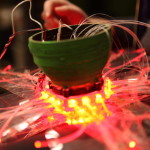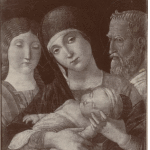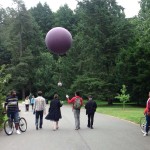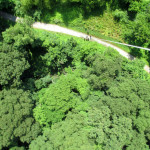American cities are having a moment, and Boston is no exception. Throughout the nation, cities are seeking to reinvent themselves (especially in the context of post-industrial soul-searching), and to orient themselves within an economy that is increasingly based on ideas, rather than on physical infrastructure. Unlike many other cities, Boston has a history as a "hub;" a unique combination of factors make it a natural site of new ideas, from its huge student population to its early adoption of the tech industry. Thanks to the branding of the city as an "innovation hub," brimming with creativity, as well as the abundance of universities and start-ups within the Greater Boston region, and the support provided by incubators and other networks, entrepreneurs are finding Boston a welcoming operational center. But how does art and creativity within the visual arts factor into this new environment?
To many people, collaboration is the answer. The rhetoric that surrounds the "innovation hub" model focuses on teamwork, and spaces like the co-working offices along the shiny waterfront "Innovation District" are designed to foster conversation and idea exchanges. In the broad view of innovation that Boston and cities across America have adopted as they seek to revitalize and re-brand, the "ideas economy" is built on a swath of professionals that includes entrepreneurs, social innovators, designers, web and social media minds, and artists. The common thread is creativity, and the focus is to bring creativities together. Of course, what matters most in the minds of many civic leaders is profit, and a frequent argument for involving art (drawing heavily from Richard Florida’s "creative class" concept) relates to what profit art can generate by attracting talented innovators drawn to certain cities because of cultural vibrancy, who will then stay to spend money and create jobs.
In some areas, however, art is also being seen as an important mode of understanding and communicating knowledge, as a useful facet of innovation in its own right. Institutions like Harvard and MIT, cornerstones of Boston’s unique authority as an innovation hub, embrace their roles as incubators for creative thinking and production. While these schools have long been associated with innovation in science and technology, more recent additions like Harvard’s metaLAB and MIT’s Center for Art, Science & Technology point to an emerging focus on interdisciplinary creativity that unites art with technology, and seeks to engage the Boston community beyond the academy. Through projects, public programs, and the recruitment of artists-in-residence, these units aim to integrate multiple forms of creativity into innovation and into ways of approaching complex issues. Current projects range from metaLAB’s conduction of a design studio focused on "technologically animating" the Harvard Art Museums to the symposium MIT is planning for next fall which will connect creative artists with scholars for dialogue on knowledge production.
While these projects point to a promising new way of thinking and doing within the academic community, there is plenty of room to increase involvement beyond the academy. Might these institutions recruit up-and-coming artistic talent in the Boston region in the same way they recruit well-known artists from around the world? In the context of nationwide trends towards collaborative and engaged scholarship, can art be used as a means of fostering shared knowledge and communication between Boston’s universities as well as the region? These questions are ripe for exploration, particularly as Boston continues to brand itself as an appealing location for recent college graduates and emerging professionals. In a recent Boston Herald article Richard Maloney, Assistant Director of BU’s Arts Administration program and a member of the Create the Vote coalition, pointed out artists’ abilities as "communicators who know how to connect with a wide variety of people through words, images, sounds, and symbols." Given Boston’s unparalleled educational resources, universities may be one catalyst for an increased focus on art’s role in fostering new knowledge and understandings. Boston prides itself on the new ideas and approaches that come out of its universities, labs, and companies, and it seems natural that a more interdisciplinary, holistic approach to creation would form the next frontier of innovation.
As the city continues its "innovation hub" push, one potential model for the integration of a strong arts scene is the network established for aspiring start-up founders and tech workers. "Innovation labs," start-up incubators, and training programs like General Assembly— which offer networking opportunities in addition to courses in nuts-and-bolts skills that range from web development to digital marketing—provide solid grounding for people starting out as entrepreneurs. Can a similar community and sense of infrastructure emerge in Boston’s art world? If investments of money, effort, and space are made in art, what innovations, in terms of world views, aesthetic moments, and new formations of ideas, are possible?
The Boston community has a stake in this question, as well as in the potential for artistic innovations to interact with and inform other modes of development and creativity. I’m interested in what’s happening on the ground, going beyond the buzzwords, to see how people interpret the city’s art community participating in the "innovation hub" moving forward. Through conversations with curators, artists, and others, I am exploring these questions. I will be discussing the perspectives and ideas raised in these conversations through a blog series published on BR&S. This city prizes talent, creative thinking and collaboration, and considering art’s role within the "innovation hub" context is vital.
- A “roboflower” made by students in Arbonauts studio, a teaching project undertaken in collaboration with the project NuVu Studio (nuvustudio.org). Courtesy of meaLAB.
- Nonmantegna.gif from metaLAB’s Curarium, a platform for crowdsourcing art history. Courtesy of metaLAB.
- From metaLAB’s Science as Spectacle at the Arnold Arboretum. Courtesy of metaLAB.
- From metaLAB’s Science as Spectacle at the Arnold Arboretum. Courtesy of metaLAB.









